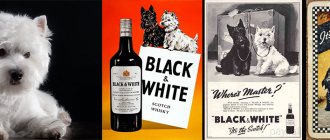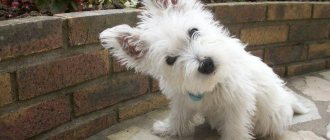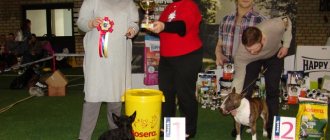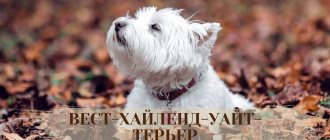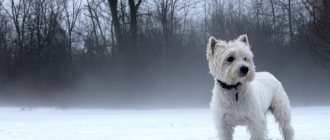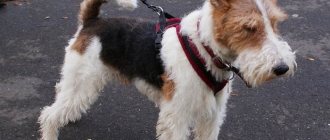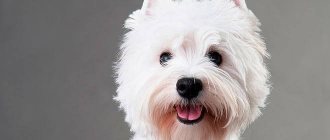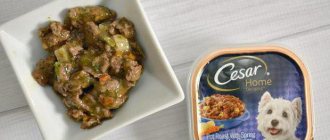Appearance of the West Highland White Terrier
The West Highland White Terrier is a snow-white, compact shaggy dog with an inquisitive look, vaguely reminiscent of a Bichon Frize. Thanks to their sweet appearance and more than modest dimensions (the height of an adult dog is up to 28 cm, weight is up to 10 kg), West Highlands are quite suitable for the role of apartment dwellers. At the same time, they are not particularly fragile, like most representatives of decorative breeds, which means the owner does not have to control every step and jump of the pet.
Head
The skull of the West Highland White Terrier is wide, slightly convex, with a pronounced stop and prominent brow ridges.
Jaws and bite
Despite the fact that the West Highland White Terrier is an almost miniature dog, its jaws are powerful. As for the bite, representatives of this breed have a full, scissor-type bite.
Eyes
The wide and fairly deep-set eyes of the West Highland White Terrier have an almond shape and a dark iris color. The dog's gaze is intelligent and insightful.
Nose
The Westie has a large, black nose, which almost does not protrude beyond the muzzle.
Ears
The West Highland White Terrier's small, pointed ears are not set too wide and are carried straight. The outer side of the ear is covered with velvety fur, which is never cut.
Neck
Dogs have a moderately long and well-muscled neck, which gradually thickens towards the body.
Frame
The body of representatives of this breed is compact, with a straight back, strong lumbar region and wide croup.
Limbs
The front legs of the West Highland White Terrier are short, well muscled and without curvature or turning outward. In some cases, the animal's paws may be slightly turned out. Experts explain this feature by the fact that during the hunt, the ancestors of today's dogs tore up the ground, throwing it to the sides, which caused the slight spread of the limbs. The hind legs of the West Highland are short but sinewy, with a fleshy and broad upper part. Dogs' paws are round, with plump pads and tightly knit toes, with the front paws being noticeably larger than the hind paws.
Tail
The Westie has a straight tail up to 15 cm long, which it carries almost vertically.
Wool
The West Highland White Terrier's coat consists of a dense furry undercoat and coarse outer coat, the length of which can reach 5 cm.
Color
The West Highland White Terrier is one of those few breeds, modern representatives of which exist in one single color - white. An important point: the color of the wool is extremely unstable and very dependent on external factors, so among animals there are often individuals whose “fur coats” have a yellowish tint.
Defects and disqualifying defects
Any more or less noticeable deviations from the standard can affect the exhibition assessment of show-class West Highland White Terriers. These are usually wavy or curly fur, large ears, a short or, conversely, excessively long neck, and atypical position of the limbs. As a rule, a dog may not be allowed to participate in competitions for two reasons: for displaying causeless aggression or cowardice, as well as for obvious defects in behavior and physical development.
WEST HIGHLAND WHITE TERRIER. CUT AND TRIMMING
TRIMMING. FROM FCI STANDARD
Coat
This is the most important thing in this breed when evaluating a dog at shows. There are specimens with a coat of excellent quality. The coat of this breed is formed by hard and straight topcoat and guard hair, soft and thick undercoat. In a dog in its prime, the length of the outer and guard hair reaches 5 cm. Defects: the hair is silky, loose, falling apart in clumps, indirect, there is no undercoat.
Color
Only white; black-pigmented mucous membranes, nose, paw pads, claws. Serious defects: rusty tint, unpigmented nose.
The West Highland White Terrier or Westie is an ideal family dog. This small, self-respecting dog is gaining more and more popularity. She has a funny, attractive appearance, gets along well with both other dogs and children, adapts well to both urban and rural life, and can live in a house, and in the yard.
The Westie is a representative of the small working Scottish Terriers, bred in Argyll, in the mountains of Scotland. As an independent breed, it has existed since 1905, when the first clubs for fans of this breed were formed.
One of the most striking characteristics of a Westie is its dazzling white coat. Decorating hair is hard and completely straight; undercoat - short, soft, dense. The quality of the coat is the main thing that is assessed by judges at shows, and in order to always maintain it in excellent condition, you need to spend a lot of effort and learn how to trim the dog correctly.
Trimming a Westie is a difficult thing, but if you strictly adhere to the established rules, your dog will always have a well-groomed, but not artificial, appearance. The Westie's hairstyle should emphasize its breed qualities: strong build, deep chest, straight, even back, powerful croup and muscular limbs.
Trimming the head of a West Highland White Terrier
The correct silhouette is given to the dog by two types of pinching: stripping - pinching using a stripping knife and placking - pinching with the index and thumb. It is strictly forbidden to use scissors as the only tool for processing wool, especially show specimens: Westie hair, like that of all terriers, is club-shaped, i.e. it is thinner at the root and widens towards the tip, which gives it rigidity. Therefore, cutting wool contributes to its thinning, and, consequently, it acquires softness that is unacceptable by the standard.
It is especially important to emphasize the neck line; protruding hairs from the tail (especially on the inside), limbs, ears and in the anus should be removed. Ideally, the hair on the back from the withers to the base of the tail should be 4-5 cm long, and shorter on the neck and throat.
There are two ways to achieve this. The first is more labor-intensive and does not involve complete removal of hair and undercoat and the use of scissors.
In this case, it is advisable to accustom the dog to trimming from the second month of life. Vigorous, 5-10-minute daily brushing will be very helpful at the initial stage. After placing the dog on the table, brush the fur as it grows. At the age of 5 months, when the puppy’s “baby” hair begins to change and the first true outer and guard hairs have already grown a little, you need to pluck the fur using the placking technique so as to give the dog the desired silhouette.
Then, until the next pinch, you need to regularly comb the dog with a slicker brush, also in the direction of hair growth.
After some time, when the new hair has matured (usually this happens within 5-6 months), the dog’s hair is stripped - a technique in which you will always create its hairstyle in the future (with the exception of the muzzle, where plating is usually used).
First, use a comb with fairly frequent flat teeth to comb out the dog’s undercoat. Then, using a stripping knife, the hair on the throat is plucked quite briefly, grabbing the sides of the neck, up to the scapulohumeral joint. On the crest of the neck, the hair is left about 5 cm long; smooth out the transitions from long to shorter hair. The neck ridge should be shaped like a slightly convex arc. They pluck the hair at the elbow, emphasizing its tight fit to the body, and align the transition from the shoulder to the forearm, so that it is a straight, plumb line from the shoulder to the floor. From the withers to the base of the tail, a straight, horizontal line is formed by stripping, leaving hair 4-5 cm long. The transition from the neck to the withers should look like a smooth arc. Quite short hair is left on the sides and ischial tuberosity, paying special attention to ensuring that the transition to the long decorative hair on the sternum (to the “skirt”) and on the hips is smooth. The “skirt” should start from a diagonal line connecting the elbow and the highest point of the groin edge. On the limbs, the hair is left at full length, only plucking out too much hair. Claws should not be visible.
The head is processed using the plaking technique; it needs to be shaped like a “chrysanthemum” from the back of the head at the top to the edge of the cheekbone at the side of the neck and along the entire surface of the lower jaw from below. Too long hair on the ears is plucked so that they do not appear shaggy.
In the second, more radical method of processing Westie, after pinching, the desired silhouette is maintained using scissors. (Attention: scissors are never used instead of pinching!).
With this option, the dog’s entire outer coat and part of the undercoat is removed using the strnpshg technique, where the hair should be short: on the throat, neck, from the withers to the end of the tail, on the sides and ischial tuberosities. On the sternum, limbs and head, the decorative hair is only lightly plucked.
After 5 weeks, when the outer coat has grown a little, the remaining undercoat is also removed. Now the growth of hair and undercoat will proceed harmoniously. But during this period of time and another month and a half later, the skin remains practically defenseless to dirt, and the dog needs to be bathed more often.
Six weeks after removing the undercoat, the hair has grown back so much that it becomes possible to model the hairstyle with scissors, leaving the desired length of hair in the right places. Do this regularly once a week! maintaining the shape of the exhibition piece. After 5-6 months, the hair will be ripe for a new stripping.
Character of the West Highland White Terrier
West Highland White Terriers are white and fluffy on the outside only. Inside, these charming “Scots” are far from being such good boys as they seem at first glance; moreover, they are quite stubborn and do not really like to obey the chain of command. At the same time, compared to their more aggressive and temperamental relatives in the terrier group, West Highland White Terriers seem, if not quite quiet, then quite manageable pets. However, this is not an innate advantage, but rather the result of the work of breeding specialists, who for a long time “extinguished” the hunting instincts of the breed and stimulated its companion qualities.
All West Highland White Terriers do not like to be ignored, and these snow-white babies do not cope well with loneliness. So before you bring a young messenger into your home, think about whether you are ready to sacrifice silence and your own peace for the sake of a four-legged nimble. West Highland White Terriers have a partnership-like relationship with children: they enjoy playing together, while both parties taking part in the process feel equal. It’s another matter if the dog has to deal with kids who, due to their thoughtlessness, can annoy it with intrusiveness or cause pain. In this case, the news will definitely fight back (guess in what way).
The West Highland White Terrier can easily delegate guard duties. Most representatives of this breed have acute hearing and are able to warn the owner about the appearance of a stranger with a ringing bark. At the same time, they do not experience any particular hostility towards strangers, which means they will not frighten your guests with sudden attacks and dissatisfied grumbling.
Despite all the efforts of breeders, the specialists in burrow hunting in West Highland White Terriers have not completely died out, so from time to time the dogs will be drawn to feats. In particular, on walks, Westies will selflessly dig trenches in search of an imaginary gopher, and when they see a garbage rat or some other small animal, they will immediately rush into battle. Treat this pet behavior with slight irony: after all, every breed has its own harmless cockroaches.
Hunting with a West Highland White Terrier
As noted earlier, it is not customary to go after foxes and badgers with today's West Highland White Terriers. Moreover, at competitions and exhibitions, representatives of this breed have long been evaluated exclusively by external parameters and almost never by working qualities. On the other hand, no one has the right to prohibit the owner of a West Highland White Terrier from going with his ward to hunt the animal. So if you are eager to try out your pet in action, sign up for any kennel club that has a training hole, and practice your pupil’s hunting talents as much as you want. As practice shows, people are extremely reckless in their work, but at the same time they do not lose their minds. In addition, they very quickly learn the habits of a wild animal and can change tactics at lightning speed if the situation requires it.
West Highland White Terrier in Rostov-on-Don, puppies and dogs
West Highland White Terrier in Rostov-on-Don - buy inexpensive pets. Advertisements with prices and photos, puppies for sale and offers to give purebred dogs as gifts for free.
West Highland White Terrier puppies
The professional West Highland White Terrier kennel “Stars Factory” offers high-breed puppies…
West Highland White Terrier puppies.
The puppies have a hard, straight coat, are hypoallergenic, do not shed, have an impeccable exterior, a cheerful disposition, are...
Animals
I will buy a West Highland Terrier girl inexpensively! Write to [email protected] com Calls are not accepted...
Buy a West Highland Terrier puppy
I will buy or accept a West Highland Terrier puppy as a gift for a child
West Highland White Terrier puppies
Pedigree Westa puppies for sale with excellent pedigree, vaccinated according to age and ready for transport...
West Highland White Terrier puppies
22,000 rub.
I offer for sale West Highland White Terrier (Westika) puppies from titled parents. Its...
West Highland White Terrier miracle babies
Magnificent puppies, cheerful, healthy, with all documents. Westies are very cheerful and playful, never...
Snow White West Highland White Terrier Puppies
West Highland White Terrier puppies from award-winning producers do not shed, do not cause allergies...
West Highland White Terrier
21,000 rub.
Snow-white babies, with an excellent pedigree, from champion parents, father is a champion of 3 countries, Grandchampion...
West Highland White Terrier puppies for sale
A grown-up Vestika girl is for sale. Vaccinated, walks outside, gets along with cats. Bargaining on the spot...
West Highland White Terrier – girl
Vestiki
Two charming West Highland White Terrier girls are looking for owners. Born on May 28.
Chic Vestiki
25,000 rub.
The special breed kennel offers for sale West Highland White Terrier puppies from a titled couple,…
West Highland White Terrier puppies
35,000 rub.
Kennel “From the House of Rachel” Offers puppies of all ages! Boys and girls from award-winning pro...
Westie puppies
35,000 rub.
We offer Westie puppies of all ages! Boys and girls from titled parents with full...
West Highland White Terrier (puppies)
West Highland White Terrier puppies from the title are offered for purchase and pre-reservation...
West Highland White Terrier puppies
36,000 rub.
Kennel "Talisera" (RKF), Krasnoyarsk, offers West Highland White Terrier puppies from a beautiful p…
West Highland White Terrier, Puppies
In our kennel RKF “DELANCE MAGIC” there are beautiful puppies for sale. West Highland White Terrier. On fo...
West Highland White Terrier puppies for sale
To your delight, we have West Highland White Terrier puppies growing up. Future champions were born...
West Highland
West Highland White Terrier puppy for sale. Born on November 25, 2016 RKF documents, veterinary passport, brand….
Maintenance and care
Every year, West Highland White Terriers are increasingly turning into indoor/sofa pets, and the reason for this is the desire of the owners to keep the soiled “fur coats” of their charges relatively clean. However, by nature, Westies are not such sissies and are quite capable of spending time outside, even if the weather leaves much to be desired. Bright, cute clothes and blankets, which West Highland White Terriers are often dressed in, are by no means a forced measure, but rather the owner’s desire to emphasize the uniqueness of his pet. In reality, West Highland White Terriers do not suffer much from the cold even in the winter months, provided, of course, that you do not keep the dog outside all day.
Trimming and cleaning the coat of the West Highland White Terrier
A pleasant bonus for fans of sterile cleanliness: West Highland White Terriers do not shed and have virtually no odor. Of course, the coat of animals is regularly renewed, but dead hairs from their “coats” do not fall out, but simply fall off. Accordingly, in order to maintain the pet’s image, it will have to be trimmed once every couple of months or, if it is a show dog, every 30 days. Grooming is prohibited for these charming shaggy dogs, as it changes the structure of the coat, softening it and causing the hair to curl into a curl. As a result, the West Highland White Terrier loses its original appearance and becomes like a hybrid of a lapdog and a Bichon Frize. However, if you are not ambitious and do not plan to go to exhibitions, you can try to cut your ward’s hair. Your self-esteem will not suffer from this at all.
Before trimming, the West Highland White Terrier is thoroughly combed, after which the throat area and the area at the elbows are treated as briefly as possible with a stripping knife. The line from the withers to the croup, as well as the ridge of the neck, is also pinched with a knife, maintaining a total length of fur of 4-5 cm and smoothing out the transitions. As an example: an exemplary West Highland White Terrier should have short hair on the sides and a so-called skirt - lush, adorning hair on the chest. The hair on the forehead, crown and cheekbones is plucked by hand (placking technique), giving the head the shape of a chrysanthemum. The hair on the legs is usually not shortened.
If you want to preserve the unique snow-white color of the West Highland White Terrier, be prepared to spend an extra hour and a half on your pet’s “fur coat.” The fact is that the fur of representatives of this breed often turns yellow when dog saliva or food gets on it, so to neutralize the unwanted undertone it is necessary to use a cleaning composition of crushed chalk and boric acid. The mixture is rubbed into slightly moistened wool, after which its chalky particles are combed out with a regular hair brush.
Hygiene
Once a month, West Highland White Terriers are bathed using diluted pet shampoo (conventional products are not suitable). Not the most useless purchase is a whitening shampoo, which allows you to preserve the exquisite shade of the Westie's coat. Just don’t test it on a puppy, otherwise you risk seriously damaging the baby’s hair structure. Otherwise, representatives of this breed are suitable for any detergent compositions designed specifically for wire-haired dogs.
Once every 5-6 days, the West Highland White Terrier should be combed with a sparse comb with metal teeth, which will not tear the undercoat, but will only gently remove dead hair and debris. But this is only if the pet’s coat is tough and healthy. Individuals with soft fur will have to be combed more often, otherwise you will get tangles. In addition, do not forget to wipe your dog’s face with a napkin after eating so that food debris does not get stuck in the fur and cause a change in its color.
Once a week, you need to pay attention to your ears: pluck out long hair that interferes with the free circulation of air inside the ear funnel, and remove dirt accumulated in the ear shell. It is best to examine the West Highland White Terrier's eyes every day. If brown streaks are found on the fur under the lower eyelids, the dog most likely has an allergy, so grab your pet and run to a veterinarian for a consultation. Westies have their teeth brushed a couple of times a week. In addition, it is useful to introduce various solid foods into the dog’s diet, particles of which act as abrasives and partially remove plaque. The paws of the West Highland White Terrier also need care, so after each walk they should be washed thoroughly, and in winter, when the roads are sprinkled with reagents, they should also be lubricated with vegetable oil.
Walk
If your West Highland White Terrier does not hunt (and he most likely does not hunt), he will have to compensate for the lack of adrenaline and positive emotions with walks and training. Westies must be taken outside at least twice, or preferably three times a day, and this should not be a 15-minute run around the playground. The first walks begin at 3 months of age, after the puppy has undergone routine vaccination and spent a week in quarantine. By the way, up to 6 months, babies are taken outside (they are taken out, not taken out) 5-6 times a day, which is due to the need to develop in them the ability to relieve themselves outside the home.
Westies love to rummage in the ground and are capable of destroying a well-groomed flowerbed or green lawn in a matter of minutes, so if you don’t want to constantly argue with landscape designers and utility workers, it’s better not to let your pet off the leash within the city. When walking with a West Highland White Terrier in nature, it is also better not to lose vigilance. Firstly, because dogs intoxicated by unfamiliar smells and sounds instantly become difficult to control. And secondly, because the Westies have a real passion for carrion, in which they prefer to wallow thoroughly before responding to the owner’s command.
Feeding
The diet of the West Highland is not much different from the menu of its other terrier brothers. In particular, half of the dog’s meal should consist of lean meat, which is supplemented with vegetables (broccoli, pumpkin, turnips), cereal porridge (rice, buckwheat), fermented milk products and fruits. However, since most dogs are prone to food allergies, menu planning should be approached with the utmost caution and preferably with the involvement of a veterinarian.
Once and for all, eliminate chicken and wheat from your West Highland White Terrier's diet. The same rule applies to industrial feed. If you find wheat flour and “chicken” in the store-bought “drying”, return this product to the shelf and never look at it again. As for vitamin supplements, you can periodically add crushed greens (nettle, dandelion, parsley), brewer's yeast and salmon oil to the food of West Highland White Terriers. Once a week it will be useful to treat your fluffy with a quail egg, and during the season you can pamper him with half an apricot, a piece of pear or a ripe plum. By the way, despite the fact that sweets are strictly prohibited for West Highland White Terriers, dogs are simply crazy about them. So when you're ready to enjoy some ice cream or candy, don't forget to hide well from the four-legged beggar.
Please note: the West Highland White Terrier's coat may change color and acquire a yellowish tint if the dog's diet includes foods containing artificial or natural dyes. For pets this is not critical, but for show-class animals such changes can seriously spoil their exhibition career.
Show trimming scheme for the West Highland White Terrier
Do not forget that the first stripping with this method of wool processing is due to the Westie at the age of one month. And one more thing: the characteristic “chrysanthemum” shape is given to the dog’s head in the traditional way using the plaking technique; decorating hair on the limbs and on the “skirt” is not plucked.
As for hygienic daily procedures and maintaining ideal whiteness of the hair on the face, they are similar for all white dogs (see articles about the Bichon Frize, Maltese, Griffon). To maintain the cleanliness of the coat, the best way is dry brushing with chalk powder (calcium carbonate) and boric acid, which are rubbed into the coat, slightly dampened, and then brushed with a natural bristle brush. If the dog needs to be dried, the same technique is used.
On the ears, long hair is trimmed approximately 14-15 weeks before the show. The head is shaped like a “chrysanthemum”. Long hair is plucked with fingers. Before trimming, the wool is combed in the direction indicated in the diagram.
On the upper part of the body, from the withers to the base of the tail, the hair length is 4-5 cm (1). The throat and sides of the neck up to the shoulder blade joint are briefly plucked (2). On the crest of the neck, the length of the hair is 5 cm. The transition from the neck to the withers forms a smooth arc (1). On the sides and ischial tuberosities the hair is short (1, 3). On the elbows, the hair is trimmed so as to emphasize its tight fit to the body. The “skirt” starts from the line connecting the elbow and the highest point of the groin (4). The transition from short to long hair is smooth. On the limbs, only protruding hair is trimmed. In the area of the anus and on the back of the tail, the hair is short (3).
Health and Diseases of West Highland White Terriers
West Highland White Terriers live an average of 13-15 years and are less prone to hereditary diseases than their terrier counterparts.
Diseases that may occur in West Highland White Terriers:
- cranial osteopathy;
- atopic dermatitis;
- epidermal dysplasia;
- ichthyosis;
- congenital deafness;
- hip dysplasia;
- diabetes;
- von Willebrand disease;
- cardiovascular diseases;
- meningoencephalitis of white dogs;
- Perthes disease;
- Shaker syndrome;
- hyperuricosuria.
How to choose a puppy
- Choose reliable, proven nurseries registered by the RKF. Usually all matings in them are planned.
- Give preference to breeders or nurseries who are ready to provide their clients with advisory support throughout the entire period of the puppy’s growing up. Unscrupulous “breeders” whose main goal is to make a profit from the sale of animals, as a rule, do not make such concessions.
- If possible, look at several litters. Offspring from different parents can differ significantly in both external and behavioral indicators.
- The gender of the West Highland White Terrier has virtually no effect on its temperament type and intellectual abilities, although it is believed that males of this breed learn faster than females.
- Assess the level of hygiene and living conditions of the puppies in the kennel. It’s great if the kids don’t sit in dirty cages, but move freely around the territory allotted to them.
- Touch the belly of the puppy you like. If additional swelling is felt in the navel area or there is bulging of the peritoneum, there is a possibility that the baby will be diagnosed with a hernia in the future.
- Responsible breeders test West Highland White Terriers for the presence of genetic diseases, so before purchasing, do not be lazy to read the results of the test, so that later you will not be surprised why your baby has health problems.
Memo to Westie puppy owners
Westie puppies
FIRST DAYS IN THE NEW HOUSE.
You brought a small member of your family into the house. In the first minutes, you need to show the puppy his place, toilet (disposable diaper or newspaper) and bowl. It is necessary that everything is located at a short distance from each other so that the puppy can see and remember everything. If there are other animals in the house, you need to gradually introduce them to the puppy. After the puppy has been shown his place, toilet and bowls, you can let the baby explore the apartment, while carefully monitoring him.
Puppy place
If the puppy is still small and under 12 weeks old, it is advisable that at first the puppy should live in a fenced-off area, or in a separate room in the apartment, where all wires and dangerous objects are removed, and sockets are closed. The puppy should be in this place most of the time during the period of adaptation to the new home, and when left alone. Westies very quickly find their way around the apartment, and after a while your baby will be able to move around everywhere.
Feeding the puppy.
It is very important not to change the puppy’s feeding during the first days. Feed only the food recommended by the breeder, unless, of course, it is Pedigree or Chappie. In the future, you can choose either natural feeding or super-premium dry food; get recommendations from the breeder or experienced West Highland owners about the correct transition of the puppy to another food. The daily feed intake is divided into several doses. Access to drinking water must be constant. The water must be changed regularly; it is better to use filtered water.
ABSOLUTELY FORBIDDEN!!! • pork in any form; • fatty lamb; • bread and pasta; • milk, sweet yoghurts, curds, cheeses and mousses; • sweets (cookies, candies, cakes, chocolate, etc.); • smoked meats (sausages, frankfurters); • bones and long tight veins; • sweet fruits and berries; • vegetables (except some in minimal quantities, the breeder will tell you more) • fried, spicy, smoked foods • alcohol, juices, sparkling water
Toilet training and walking.
1. If the puppy is not fully vaccinated, or is in quarantine, you need to accustom him to the home toilet, this can be disposable diapers, newspapers. It is necessary to place more diapers and newspapers, several in each room in the apartment (house) where the puppy is, so that the baby does not miss. In the future, excess diapers and newspapers can be removed, leaving only those that the puppy uses most often. To toilet train your baby, you need to sit him down quite often. Before meals, after meals, between meals and during games. On average, a small puppy pees every 2-3 hours. You can see by his behavior when he wants to go to the toilet. The baby begins to sniff, spin, and sit down; at this moment you need to pick up the puppy and take it to the diaper. It is imperative to praise your baby for going to the toilet correctly. Praising is fun and emotional! As a rule, after 3-4 days the puppy begins to defiantly sit on a diaper or newspaper to receive praise.
2. While the puppy gets used to the diaper in a new place, it is better to remove carpets and rugs.
3. It is necessary to accustom the puppy to walks after the second revaccination, after the required quarantine period. At first, you need to take the puppy outside as often as possible, after sleep, after eating. On average this is 6-8 times a day. We must not forget to praise the baby and rejoice greatly at his successes! The first walks are usually short, up to half an hour. In the future, the number of walks should be gradually reduced. An adult dog usually walks 3 times a day; for some, two walks are enough. Remember that terriers are very energetic and sociable dogs, they love to run and jump, so during walks, try to play as much as possible, throw a stick or a ball, so that the puppy is interested in walking with you. On walks, be careful that your puppy does not pick up things from the ground. To do this, you can carry a homemade rattle with you, which can easily distract the puppy from eating on the street. The rattle is an aluminum can with coins (like soda water) that you will throw next to the puppy when he tries to pick up from the ground (attention, do not throw at the puppy himself!). Remember, before you throw the rattle, you must say loudly and clearly “Ugh!” and only then quit. When the puppy is distracted, immediately praise him and call him, show him how happy you are, you can also treat him with a small piece of low-fat cheese. It is also very easy to teach your baby to run up to you on the command “Come to me!” Call the puppy first from a very close distance, and treat him to a small piece of low-fat cheese. Puppies very quickly understand that calling is followed by a treat, and they happily run up on command. Also make sure that your puppy does not run up to unfamiliar dogs on the street. It's always best to hold the puppy first and ask the owners of the other dog's dog if it is aggressive.
Home safety and toys.
You cannot place the puppy on chairs, armchairs, sofas, or beds. The puppy may fall from a great height, causing serious injury and damage. Most puppies are very playful and lively. They need to be handled very carefully, close the doors carefully, look at your step, and carefully monitor the puppy and its movements. In addition, at home you should try to remove everything unnecessary that could attract the puppy’s attention and be spoiled by him. Shoes should be removed and only toys intended for the puppy should be left on the floor - rubber toys, ropes, stringy bones. Early games of tug of war can damage a small puppy's bite, so try to avoid this. The puppy must chew - growing teeth require this and you need to provide him with the appropriate items - toys, so that he does not spoil things. It is necessary to strictly monitor the electrical wires so that they are not laid across the floor under any circumstances. If you do not want an adult dog to sleep with you, do not take the puppy to bed from the first minutes.
Puppy care
The terrier's coat requires care. It is necessary to bathe the puppy as soon as it gets dirty. Any puppy mild shampoo will do. It is best to dilute any shampoo with water before use. You must bathe your puppy very carefully, making sure that water does not directly get into the ears. After bathing, wrap your puppy in a terry towel. After a few minutes, dry the puppy with light movements. Afterwards it is better to dry the wool with a hairdryer, warm, not hot!!!, with a stream of air. It is unlikely that the baby will like the first bath; talk to him, encourage him, hold him gently, but at the same time firmly, so that the puppy does not slip out of your hands. More detailed information about caring for the Westie coat can be obtained from specialized literature and on breed forums. And also from the breeder. Remember that West Highlands are wire-haired terriers and require regular trimming. The first trimming of a puppy is usually done at the age of 12-16 weeks. In the future, the puppy, and then the adult dog, must be shown to the groomer once every 8-12 weeks, and if you plan to attend exhibitions, then more often. The trimming master will tell you in more detail; he will create an individual scheme for working with hair for your dog. Try not to go to dog beauty salons. It is best to contact a breeder or trainer who seriously and professionally works with West Highlands and can properly trim your puppy. The dog must be regularly examined and treated for fleas and ticks. Flea drops are more effective than flea collars. You can also use sprays. Be sure to inspect your pet’s fur after a walk, as tick repellents do not provide 100% protection. Puppy collars should be comfortable, wide and soft; garrotes should absolutely not be used. The use of harnesses is also undesirable. You can choose a leash or tape measure at your discretion.
What will the puppy need?
1. Toilet diaper or newspaper. 2. Food, necessarily the one that the breeder fed the puppy. In the future, it will be possible to switch the dog to another food or type of feeding. 3. Bowls for water and food. Better stable plastic, metal or ceramic ones, with low sides for food and deeper for water. When the puppy grows up, you can purchase bowls on a stand that is adjustable according to the dog’s height. 4. Sleeping place: a soft house or bed, about 60-70 cm wide, so that even an adult Westie would be comfortable. 5. Toys: toys with squeakers, ropes, balls, large stringy bones (so that the puppy does not choke) 6. A carrying bag for trips or a plastic box. It is very convenient to transport a dog in a box in a car. I recommend securing the box with seat belts so that the box does not tip over during heavy braking. 7. Brushes for combing: a massage brush with metal teeth without balls at the ends, a comb, a soft slicker slicker. For show grooming of a mature and adult dog, you will need other tools, which your breeder or groomer will tell you about. 8. Scissors for cutting ears, paws, butts. 9. Nail clippers for trimming nails. 10. Separate towel. 11. A plastic bottle (can be taken from a liquid soap with a dispenser or other) for diluting shampoo and conditioner; 12. Shampoo for puppies is hypoallergenic. 13. If the first walks with the puppy are planned for the cold season, it is better to purchase a knitted vest so that the baby does not freeze. Adult Westies do not freeze, so there is no need to wear them. In rainy weather, you can use a raincoat. 14. Soft, comfortable collar and leash.
REMEMBER, for any questions related to the puppy’s health, be sure to seek advice from the breeder and good, trusted veterinary clinics
Piroplasmosis in dogs. Prevention and treatment.
Cleaning your dog's anal glands
West Highland White Terrier puppies. How to buy a Westie puppy.
